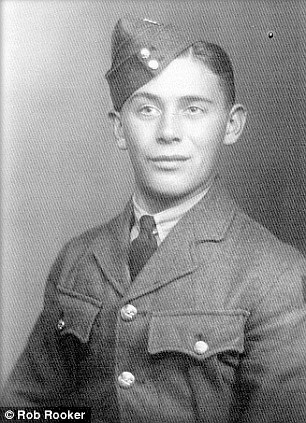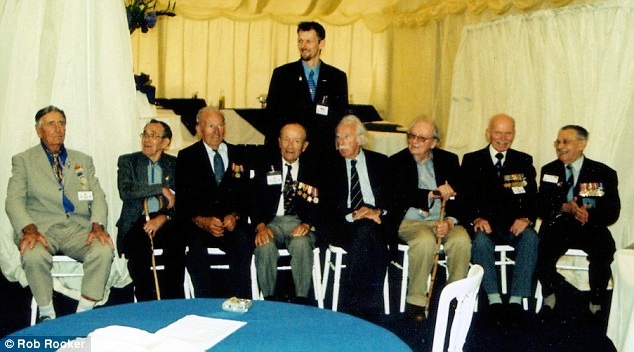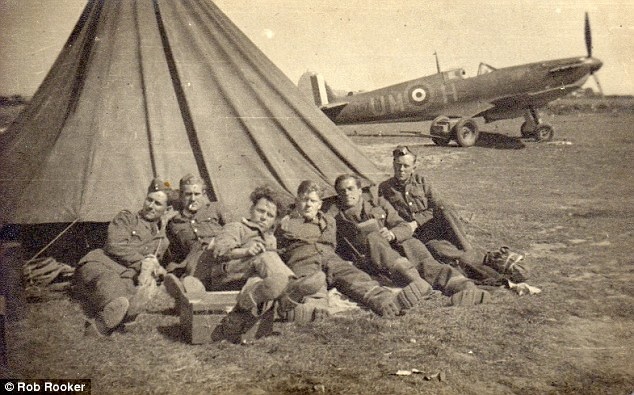'Seeing their faces when they meet makes all the hard work worth it': Father-of-two dedicates life to reuniting members of RAF squadron who fought in Second World War
-
•Security worker Rob Rooker has spent 18 years reuniting 50 members
-
•Most of them are now in their 90s and live as far afield as South Africa
-
•His biggest achievement was getting eight together in 2006 at Duxford
-
•Four flew together in Burma and had not seen each other for 60 years
-
•His research grew from weekend project looking at RAF base in Dorset
EXCLUSIVE By Mark Duell
PUBLISHED: 10:58, 27 December 2013 | UPDATED: 10:58, 27 December 2013
It all started almost two decades ago, when Rob Rooker began a small weekend project to look into Royal Air Force squadrons which flew out of a base in Dorset during the Second World War.
The father-of-two soon realised he was onto something interesting when looking further into 152 (Hyderabad) Squadron - and decided to attempt to reunite as many former members as possible.
The 44-year-old, of Ipswich, Suffolk, has spent 18 years reuniting as many as 50 former members - most of whom are now in their 90s - from as far afield as South Africa, Canada and Australia.

Reunion: Rob Rooker reunites three former members of 152 (Hyderabad) Squadron at RAF Cranwell in Sleaford, Lincolnshire, in July 2012 - William Smith (far left), 86, John Anderson (centre left), 93, and Ray Johnson, 93

Teamwork: 152 Squadron in India in 1944. It was flying over 1,000 operational hours a month by November 1944 - destroying three aircraft in a Japanese raid in February 1945

Abroad: In 1943, a move to Malta enabled the squadron to work up for the Sicilian invasion - and it destroyed 12 enemy aircraft in one dogfight in July that year. The groundcrew are pictured in Malta in 1943


Decades later: Sergeant Ray Johnson aged 19 (left) and 93 (right), holding a copy of a book about the squadron. Mr Rooker said his research has given Mr Johnson 'something to live for' after his wife died

Team photo: Mr Rooker stands in 2006 at Duxford with (left-to-right) E. 'Lofty' Unsted, now dead; C. Potter, 90; A. Gray, dead; J. Davis, dead; K. Plumridge, dead; T. Tooth, dead; J. Anderson, 93, and R. Johnson, 93
He marks his most memorable achievement as reuniting eight ex-members in 2006 at Duxford in Cambridgeshire. Four had flown together in Burma and had not seen each other for 60 years.
Mr Rooker told MailOnline: ‘Seeing their faces when they all met up made all the hard work worth it. I had a great day, finally meeting them face to face, and meeting some of their families.
‘Sadly, many of them have now passed away, but I still have the memories and the knowledge that I was able to help them meet up with old friends again.’
Mr Rooker decided to start researching RAF Warmwell - which had been a fighter station in Dorset during the Battle of Britain in 1940 - at his local library after reading a newspaper article about it.

Taking a break: In July 1940 the squadron became based at RAF Warmwell in Dorset to defend Portland Naval Base. The groundcrew are pictured at Warmwell in 1940

'Old faithful': Eric Boy Marrs sits for a photograph at RAF Warmwell at the time of the Battle Of Britain in 1940


Then and now: John Anderson is seen (left) at RAF Warmwell in late 1940 and (right) aged 93 in the present day

Stifling heat: The squadran took part in Operation Torch - the invasion of French North Africa - landing at Algiers before performing sweeps in the Tunis area. Members are pictured here in North Africa in 1943

In the sky: The squadron's planes are seen in flight and on the ground at Lentini in Italy in 1943
He found that 16 squadrons flew from Warmwell from 1940 to 1945, and eventually chose to write to ex-members of 152 through The Battle of Britain Historical Society, before waiting to hear back.
He received a call from one man, who said he had served with 152 and would send him a letter with some photographs. Then, Mr Rooker received a call which, in his words, would ‘change my life’.
This caller told him: ‘I am ex-sergeant Ray Johnson, of 152 Squadron. Can I ask what you're doing with my squadron?’ After Mr Rooker explained his project, Mr Johnson said he would help him.
The former sergeant also revealed he had been in contact with other members who wanted to help out - and soon after, Mr Rooker began to receive more letters offering help and providing stories.

Posinh: Warrant officers Cyril Potter and Bob Kinch in this image of the squadron in Tengah, Singapore, in 1945

Black panther: Group Captain Paul 'Gus' Ardeline, 96, who now lives in Canada. Bonnie McGurk - his daughter - said she was very grateful on behalf of the squadron to Mr Rooker for his efforts


Veterans: Leading Aircraftman Paul Kellehar (left), 93, from Canada, who served at RAF Warmwell from 1940 to 1941, whose son saw an advert from Mr Rooker placed in the Daily Mail. The late warrant officer Eric Clegg, who served from 1943 to 1945, is pictured (right) with his son Colin. Mr Clegg Snr died in May

Taking shade: From left to right, P. Ardeline, H.A. Bray, L.A. Smith, M.S. Jones, V. Papps, E. Clegg and L.J.P. Turner in 1944 in Imphal, India. Mr Clegg (second right) is also pictured more recently in the photo above
He said: ‘The main reason I do this for is Ray. It gave him something to live for (after his wife died). He’s like a granddad to me. I phone him every week to check he’s okay.’
'I enjoy helping these guys. It’s not about me. It’s about them - if you can let them know that the generations to come are going to remember them'
Rob Rooker
Mr Rooker began to link up former 152 members through posting adverts in local newspapers around Britain, and ‘lots of telephone calls’, as well as launching a website in June 2002.
He added: ‘I had no interest in the RAF whatsoever before. I’m just a normal guy - I’m into heavy metal. When I go and see the guys I turn up in a baseball cap. I don’t put on airs and graces.
‘I think it’s about the buzz of being able to help people. But I don’t do it for the credit. I think it’s more to do with helping the guys, just to see a picture they’d never seen before.’

Crew: S. Williams, B. Crabb, A. McKay, S. Cooke and J. Richards are pictured in what look like hot conditions


Members of 152 Squadron: Flying officer Frank Lee (left), 90, and Flight Sergeant Stan Williams (right), 91

Identified: Members of 152 Squadron are pictured in 1944 in Imphal, India. The squadron was first formed in October 1918 in Rochford, Essex, and almost immediately went to Carvin, France

Historic: The MK 8 Spitfire flown by fighter pilot Paul 'Gus' Ardeline, pictured in Imphal, India, in 1944

On tour: Mr Rooker, a security worker, has now bought a marquee which he hopes to take around to various events around Britain as a tribute to the members of the squadron

Mobile exhibition: Mr Rooker said he has enjoyed 'helping the guys' and showing them pictures 'they'd never seen before'
DEFENCE AND ATTACK: A PROFILE OF 152 SQUADRON (1918-1967)
152 Squadron was formed in October 1918 in Rochford, Essex, and almost immediately went to Carvin, France, less than four weeks before the end of the First World War - so had little opportunity to impress at that stage.
It reformed in October 1939 and went operational three months later, flying coastal and convoy patrols - and soon shot down a Heinkel He 111 over the North Sea coast.
In July 1940 the squadron became based at RAF Warmwell in Dorset to defend Portland Naval Base, and later moved west to Portreath, Cornwall. One year later it was escorting Bristol Blenheim on anti-shipping strikes off the Brittany coast and from mid-August 1941 moved to various airfields.
Then in August 1942 it went to Angle, Pembrokeshire - however, it again saw little action because it was mainly involved in convoy patrols. But three months later it took part in Operation Torch - the invasion of French North Africa - landing at Algiers before performing sweeps in the Tunis area.
In 1943, a move to Malta enabled the squadron to work up for the Sicilian invasion - and it destroyed 12 enemy aircraft in one dogfight in July that year. In October 1943 it moved to India and became operational there as part of Calcutta’s defence. In December the squadron shot down its first Japanese aircraft.
It continued to perform various missions and was flying over 1,000 operational hours a month by November 1944 - destroying three aircraft in a Japanese raid in February 1945.
Following the conclusion of the war, the squadron moved to Tengah in Singapore and was disbanded in March 1946.
A number of reformations followed - and 152 was heavily involved in the Kuwait operation when Iraq threatened the Sheikdom in July 1961. But it was disbanded again at Muharraq in Bahrain in December 1967.
Ten years after the website began, in June 2012 a book about the squadron was launched called ‘Birth of The Black Panthers’ by Bill Smith - the brother of the late flying officer Len Smith.
Along with warrant officer Jeff Duvall, he had come up with the logo of a panther over the roundel on the squadron’s Spitfires, after it moved to Burma in 1943 - and 152 became the ‘Black Panthers’.
Bonnie McGurk - the daughter of 152 fighter pilot Paul ‘Gus’ Ardeline, who lives in Canada - said she was very grateful on behalf of the squadron to Mr Rooker for his efforts.
She told MailOnline: ‘He is very thoughtful and compassionate and has used his incredible knowledge to honour the 152 members and their families.
‘Thanks to Rob the contributions made by the squadron will be remembered for all time. He is an extraordinary person, and one we are honoured to know.’
Some of the other members he has found and linked up in Britain include warrant officer Bob Kinch, 90, and flight sergeant Stan Wiliams, 91, who live in Cornwall and Somerset respectively.
He said he even learned of 93-year-old Paul Kellehar, a ground crew member of 152 - which got its full name from becoming the gift squadron of Hyderabad, India - living in Canada after the veteran's son spotted an appeal for members to get in touch on the Daily Mail's letters page.
Mr Rooker, a security worker who lives with his wife Liz, 37, has now bought a marquee which he hopes to take around to various events around Britain as a tribute to the members of the squadron.
He said: ‘My wife’s very supportive – she has to be. I take her to air shows. She likes seeing the planes but it must get boring for her. The spare bedroom is full of all the stuff.’
Mr Rooker added: ‘I do it because I enjoy helping these guys. It’s not about me. It’s about them - if you can let them know that the generations to come are going to remember them.
‘Some of the stories, you think it wasn’t all glory. What the guys went through... They’re not a famous squadron. They’re just a bunch of guys who were doing a job.’
-
•Mr Rooker asks anyone who might want to find out more about 152 Squadron or know someone who was involved to contact him through his website by clicking here